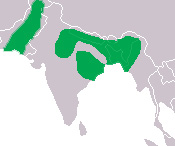
Weights and measures
| Length | from 3,5 to 7 m |
|---|---|
| Weight | from 160 to 180 kg |
State of endangerment
| Endangered |
Animal description
The Gharial (Gavialis gangeticus), also known as the gavial or the fish-eating crocodile, is a distinctive and critically endangered crocodilian native primarily to the Indian subcontinent. This remarkable species stands out not only for its conservation status but also for its unique physical features and ecological niche.One of the most striking characteristics of the Gharial is its exceptionally long, narrow snout, which is unlike that of any other crocodilian. This snout becomes more pronounced and elongated as the animal matures, especially in males. The narrow jaws are lined with a large number of interlocking, razor-sharp teeth designed to catch and hold onto slippery fish, their primary diet. This specialized snout is an excellent example of evolutionary adaptation, allowing the Gharial to minimize water resistance and snap up fish with remarkable efficiency.
Adult males are easily distinguishable by a bulbous growth at the tip of their snout, known as a 'ghara' (after the Indian word for 'pot'), which is used to emit a buzzing sound during mating rituals and as a visual display to assert dominance. This feature adds to their distinctive appearance and plays a crucial role in their mating behaviors.
Gharials are among the largest of the crocodilian species, with males reaching lengths of up to 6 meters (20 feet), though such large specimens have become increasingly rare due to a range of threats to their survival. Females are smaller, usually not exceeding 4.5 meters (14.8 feet) in length. Their body is elongated, and they possess a powerful tail, which provides propulsion and steering while swimming. The limbs of a Gharial are relatively small and weak, making them adept swimmers but poor movers on land. They can, however, slide along riverbanks to bask in the sun or lay eggs.
The skin of the Gharial is thick and tough, covered in scales that provide protection. Their coloration is a dark olive or grey on the back, transitioning to a lighter yellow or cream on the belly, which helps them blend into their riverine habitats.
Gharials are found in the fast-flowing rivers of the northern Indian subcontinent, with small populations in India and Nepal. They prefer deep waters where they can use their swimming prowess to catch fish. Their presence is an indicator of clean river systems, as they require clear, unpolluted water for survival.
Breeding typically occurs in the dry season, with nests being constructed on sandy riverbanks. Females lay between 20 to 95 eggs, which are among the largest of any crocodilian species. The eggs are incubated for about 90 days, with hatchlings emerging at the onset of the monsoon season. Young Gharials spend their initial years in shallow, calmer parts of the river where they are less vulnerable to predators and can find ample food.
The Gharial population has drastically declined over the past few decades, with current estimates suggesting fewer than 250 breeding adults remaining in the wild. This decline is attributed to a range of human-induced factors, including habitat destruction, pollution, entanglement in fishing nets, and the depletion of fish resources due to overfishing. Conservation efforts are ongoing, with several breeding and reintroduction programs aiming to bolster the wild population, but the Gharial remains critically endangered, teetering on the brink of extinction.
The Gharial's struggle for survival highlights the urgent need for conservation action to protect these unique creatures and their habitats. Their decline serves as a poignant reminder of the fragile balance of river ecosystems and the impact human activity can have on the world's biodiversity.
Map of occurrence

New photos of animals
Top 10 animals
- Dolphin gull (Leucophaeus scoresbii)
- Diana monkey (Cercopithecus diana)
- Moustached guenon (Cercopithecus cephus)
- Galápagos tortoise (Geochelone nigra complex)
- Japanese macaque (Macaca fuscata)
- Russian tortoise (Testudo horsfieldii)
- Stone loach (Barbatula barbatula)
- Greek tortoise (Testudo graeca)
- Common flying dragon (Draco volans)
- Vendace (Coregonus albula)